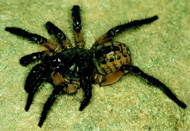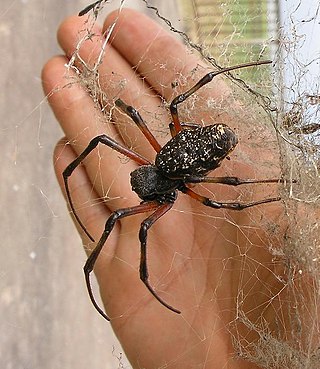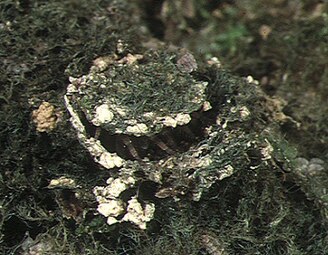
Heptathela kimurai, the Kimura spider, or kimura-gumo, is an Old World spider, found primarily in Japan and named after Arika Kimura, who collected it in 1920. It belongs to the sub-order Mesothelae and can reach up to 3 cm in length. Its burrows are covered by a camouflaged "pill box" flap.

The family Dipluridae, known as curtain-web spiders are a group of spiders in the infraorder Mygalomorphae, that have two pairs of booklungs, and chelicerae (fangs) that move up and down in a stabbing motion. A number of genera, including that of the Sydney funnel-web spider (Atrax), used to be classified in this family but have now been moved to Atracidae.

The Mesothelae are a suborder of spiders. As of April 2024, two extant families were accepted by the World Spider Catalog, Liphistiidae and Heptathelidae. Alternatively, the Heptathelidae can be treated as a subfamily of a more broadly circumscribed Liphistiidae. There are also a number of extinct families.

The spider family Liphistiidae was first recognized by Tamerlan Thorell in 1869. When narrowly circumscribed, it comprises a single genus Liphistius, native to Southeast Asia; as of April 2024, this was the circumscription accepted by the World Spider Catalog. The family contains the most basal living spiders, belonging to the suborder Mesothelae. The family has also been circumscribed more broadly to include the family Heptathelidae as a subfamily, Heptathelinae, with the narrowly circumscribed Liphistiidae becoming the subfamily Liphistiinae.

Heptathela is a genus of spiders that includes the Kimura spider. They are trapdoor spiders of the family Heptathelidae and are found in Japan, including Okinawa and the Ryukyu Islands. Spiders of this genus lack venom glands.

Spider taxonomy is that part of taxonomy that is concerned with the science of naming, defining and classifying all spiders, members of the Araneae order of the arthropod class Arachnida with more than 48,500 described species. However, there are likely many species that have escaped the human eye to this day, and many specimens stored in collections waiting to be described and classified. It is estimated that only one third to one half of the total number of existing species have been described.

Opisthothelae is a suborder of spiders within the order Araneae, containing Mygalomorphae and Araneomorphae, but excluding Mesothelae. The Opisthothelae are sometimes presented as an unranked clade and sometimes as a suborder of Araneae. In the latter case, Mygalomorphae and Araneomorphae are treated as infraorders.

Liphistius is a genus of basal trapdoor spiders in the family Liphistiidae. They are found in Japan, China, and Southeast Asia.

Ryuthela is a spider genus in the family Heptathelidae. This genus, as well as their closest relatives, Heptathela, formed when land masses from present-day Japan separated from the rest of Asia, forming islands in the late Miocene. Speciation of Ryuthela and Heptathela also occurred during this time, because of the further separation of islands, causing allopatric speciation.
Songthela is a spider genus in the family Heptathelidae, with species found in China and Vietnam.

Ryuthela tanikawai is a species of spider in the family Liphistiidae.

Herennia multipuncta, commonly known as the spotted coin spider, is a species of spider in the family Nephilidae native to Asia. It exhibits sexual dimorphism, the female being much larger than the male. It weaves a small web on the trunk of a tree or the wall of a building and is well camouflaged by its dappled colouration.
Ganthela is a genus of spiders in the family Heptathelidae. It was first described in 2015 by Xu & Kuntner. As of 2017, it contains 7 species, all of them from China.

Qiongthela is a genus of spiders in the family Heptathelidae. As of 2021, it contains 14 species.
Sinothela is a possible genus of spiders in the family Heptathelidae. It was first described in 2003 by Haupt. The type species Heptathela sinensis had been described in 1932 based on a female specimen, but was transferred to the new genus Sinothela based on a male specimen that cannot be confidently matched to the female, so both Sinothela sinensis and Sinothela are considered to be nomina dubia.
Vinathela is a genus of spiders in the family Heptathelidae. It was first described in 2000 by Ono. As of 2017, it contains 7 species. Two species were formerly placed in the genus Nanthela, now submerged into Vinathela.

Nephilingis is a genus of spiders in the family Nephilidae. It was split off from the genus Nephilengys in 2006. Both genera have been called hermit spiders from the habit of staying in their retreats during the day; alternatively the name "hermit spider" may be reserved for Nephilingis, with Nephilengys species called "eunuch spiders".
Eburneana wandae is a species of jumping spider in the genus Eburneana that mimics ants. It was named by Tamás Szűts after the Polish arachnologist Wanda Wesołowska. The male of the species was first described in 2003, with the holotype found in the forests of central Africa. It is a relatively large spider, 8.2 millimetres (0.32 in) long, and is distinguished from the similar Eburneana scharffi by its different geography, being found in Cameroon rather than Tanzania, and the shape of the spider's front legs.
Luthela is a genus of spiders in the family Heptathelidae, found in China.














